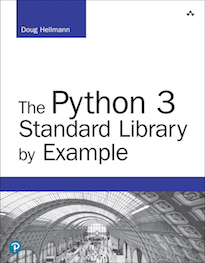io — Text, Binary, and Raw Stream I/O Tools¶
| Purpose: | Implements file I/O and provides classes for working with buffers using file-like API. |
|---|
The io module implements the classes behind the interpreter’s
built-in open() for file-based input and output operations. The
classes are decomposed in such a way that they can be recombined for
alternate purposes, for example to enable writing Unicode data to a
network socket.
In-memory Streams¶
StringIO provides a convenient means of working with text in
memory using the file API (read(), write(), etc.). Using
StringIO to build large strings can offer performance savings
over some other string concatenation techniques in some
cases. In-memory stream buffers are also useful for testing, where
writing to a real file on disk may slow down the test suite.
Here are a few standard examples of using StringIO buffers:
import io
# Writing to a buffer
output = io.StringIO()
output.write('This goes into the buffer. ')
print('And so does this.', file=output)
# Retrieve the value written
print(output.getvalue())
output.close() # discard buffer memory
# Initialize a read buffer
input = io.StringIO('Inital value for read buffer')
# Read from the buffer
print(input.read())
This example uses read(), but the readline() and
readlines() methods are also available. The StringIO
class also provides a seek() method for jumping
around in a buffer while reading, which can be useful for rewinding if
a look-ahead parsing algorithm is being used.
$ python3 io_stringio.py
This goes into the buffer. And so does this.
Inital value for read buffer
To work with raw bytes instead of Unicode text, use BytesIO.
import io
# Writing to a buffer
output = io.BytesIO()
output.write('This goes into the buffer. '.encode('utf-8'))
output.write('ÁÇÊ'.encode('utf-8'))
# Retrieve the value written
print(output.getvalue())
output.close() # discard buffer memory
# Initialize a read buffer
input = io.BytesIO(b'Inital value for read buffer')
# Read from the buffer
print(input.read())
The values written to the BytesIO must be bytes
rather than str.
$ python3 io_bytesio.py
b'This goes into the buffer. \xc3\x81\xc3\x87\xc3\x8a'
b'Inital value for read buffer'
Wrapping Byte Streams for Text Data¶
Raw byte streams such as sockets can be wrapped with a layer to handle
string encoding and decoding, making it easier to use them with text
data. The TextIOWrapper class supports writing as well as
reading. The write_through argument disables buffering, and
flushes all data written to the wrapper through to the underlying
buffer immediately.
import io
# Writing to a buffer
output = io.BytesIO()
wrapper = io.TextIOWrapper(
output,
encoding='utf-8',
write_through=True,
)
wrapper.write('This goes into the buffer. ')
wrapper.write('ÁÇÊ')
# Retrieve the value written
print(output.getvalue())
output.close() # discard buffer memory
# Initialize a read buffer
input = io.BytesIO(
b'Inital value for read buffer with unicode characters ' +
'ÁÇÊ'.encode('utf-8')
)
wrapper = io.TextIOWrapper(input, encoding='utf-8')
# Read from the buffer
print(wrapper.read())
This example uses a BytesIO instance as the stream. Examples
for bz2, http.server, and subprocess demonstrate
using TextIOWrapper with other types of file-like objects.
$ python3 io_textiowrapper.py
b'This goes into the buffer. \xc3\x81\xc3\x87\xc3\x8a'
Inital value for read buffer with unicode characters ÁÇÊ
See also
- Standard library documentation for io
- HTTP POST example – Uses the
detach()ofTextIOWrapperto manage the wrapper separately from the wrapped socket. - Efficient String Concatenation in Python – Examines various methods of combining strings and their relative merits.
 PyMOTW-3
PyMOTW-3